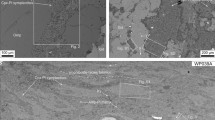Abstract
The vesicularity of juvenile clasts in pyroclastic deposits gives information on the relative timing of vesiculation and fragmentation, and on the role of magmatic volatiles versus external water in driving explosive eruptions. The vesicularity index and range are defined as the arithmetic mean and total spread of vesicularity values, respectively. Clast densities are measured for the 16–32 mm size fraction by water immersion techniques and converted to vesicularities using measured dense-rock equivalent densities. The techniques used are applied to four case studies involving magmas of widely varying viscosities and discharge rates: Kilauea Iki 1959 (basalt), Eifel tuff rings (basanite), Mayor Island cone-forming deposits (peralkaline rhyolite) and Taupo 1800 B.P. (calc-alkaline rhyolite). Previous theoretical studies suggested that a spectrum of clast vesicularities should be seen, depending on the magma viscosity, eruption rate, and the presence and timing of magma: water interaction. The new data are consistent with these predictions. In magmatic “dry” eruptions the vesicularity index lies uniformly in the range 70%–80% regardless of magma viscosity. For high viscosities and eruption rates the vesicularity ranges are narrow (< 25%), but broaden to between 30% and 50% as the viscosity and eruption rates are lowered and the volatiles and magma can de-couple. In phreatomagmatic “wet” eruptions, widely varying clast vesicularities reflect complex variations in the relative timing of vesiculation and water-induced fragmentation. Magma:water interaction at an early stage greatly reduces the vesicularity indices (< 40%) and broadens the ranges (as high as 80%), whereas late-stage interaction has only a minor effect on the index and broadens the range to a limited extent. Clast vesicularity represents a useful third parameter in addition to dispersal and fragmentation to characterise pyroclastic deposits.
Similar content being viewed by others
References
Blackburn EA Wilson L, Sparks RSJ (1976) Mechanisms and dynamics of strombolian activity. J Geol Soc Lond 132:429–440
Chouet B, Hamisevicz N, McGetchin TR (1974) Photoballistics of volcanic jet activity at Stromboli, Italy. J Geophys Res 79:4961–4976
Eichelberger JC, Carrigan CR, Westrich HR, Price RH (1986) Non-explosive silicic volcanism. Nature 323:598–602
Fisher RV, Schmincke H-U (1984) Pyroclastic rocks. Springer, Berlin Heidelberg New York Tokyo, pp 1–472
Houghton BF, Hackett WR (1984) Strombolian and phreatomagmatic deposits of Ohakune Craters, Ruapehu, New Zealand: a complex interaction between external water and rising basaltic magma. J Volcanol Geotherm Res 21:207–231
Houghton BF, Schmincke H-U (1986) Mixed deposits of simultaneous strombolian and phreatomagmatic volcanism: Rothenberg volcano, East Eifel volcanic field. J Volcanol Geotherm Res 30:117–130
Houghton BF, Wilson CJN, Weaver SD (1985) Strombolian deposits at Mayor Island: “basaltic” eruptive styles displayed by a peralkaline rhyolitic volcano. NZ Geol Surv Record 8:42–51
Houghton BF, Wilson CJN, Weaver SD (1987) The Opo Bay tuff cone, Mayor Island: interaction between rising gas-poor pantelleritic magma and external water. NZ Geol Surv Record 18:79–86
Jaupart C, Vergniolle S (1988) Laboratory models of hawaiian and strombolian eruptions. Nature 331:58–60
Kokelaar BP (1986) Magma-water interactions in subaqueous and emergent basaltic volcanism. Bull Volcanol 48:275–290
McBirney AR (1963) Factors governing the +nature of submarine volcanism. Bull Volcanol 26:455–469
Pyle DM (1989) The thickness, volume and grainsize of tephra fall deposits. Bull Volcanol 51:1–15
Richter DH, Eaton JP, Murata KJ, Ault WU, Krivoy HL (1970) Chronological narrative of the 1959–60 eruption of Kilauea Volcano, Hawaii. US Geol Surv Prof Pap 537E:1–73
Ruelo HB (1983) Morphological and crater development of Mt Tabaro eruption site, Taal volcano, Philippines. Philippine J Volcanol 1:19–68
Self S, Sparks RSJ (1978) Characteristics of widespread pyroclastic deposits formed by the interaction of silicic magma and water. Bull Volcanol 41:1–17
Sparks RSJ (1978) The dynamics of bubble formation and growth in magmas: a review and analysis. J Volcanol Geotherm Res 3:1–37
Sparks RSJ, Brazier S (1982) New evidence for degassing processes during explosive eruptions. Nature 295:21–23
Stearns HT (1925) The explosive phase of Kilauea volcano, Hawaii, in 1924. Bull Volcanol 5:193–208
Swanson DA (1973) Pahoehoe flows from the 1969–1971 Mauna Ulu eruption, Kilauea volcano, Hawaii. Geol Soc Am Bull 84:615–626
Thorarinsson S, Einarsson T, Sigvaldason GE, Elisson G (1964) The submarine eruption off the Vestmann Islands. Bull Volcanol 27:435–445
Vergniolle S, Jaupart C (1986) Separated two-phase flow and basaltic eruptions. J Geophys Res 91:12842–12860
Walker GPL (1973) Explosive volcanic eruptions — a new classification scheme. Geol Rundsch 62:431–446
Walker GPL (1980) The Taupo pumice: product of the most powerful known (ultraplinian) eruption? J Volcanol Geotherm Res 8:69–94
Walker GPL (1981a) Plinian eruptions and their products. Bull Volcanol 44:223–240
Walker GPL (1981b) Characteristics of two phreatoplinian ashes and their water-flushed origin. J Volcanol Geotherm Res 9:395–407
Walker GPL (1981c) The Waimihia and Hatepe plinian deposits from the rhyolitic Taupo volcanic centre. NZ J Geol Geophys 24:305–324
Walker GPL, Croasdale R (1972) Characteristics of some basaltic pyroclastics. Bull Volcanol 35:303–317
Wilson CJN, Walker GPL (1985) The Taupo eruption, New Zealand. I. General aspects. Phil Trans R Soc London A314:199–228
Wilson L, Head JW (1981) Ascent and eruption of basaltic magma on the earth and moon. J Geophys Res 86:2971–3001
Wilson L, Sparks RSJ, Walker GPL (1980) Explosive volcanic eruptions, IV, the control of magma properties and conduit geometry on eruption column behaviour. Geophys J R Astron Soc 63:117–148
Wohletz KH (1986) Explosive magma-water interactions: thermodynamics, explosion mechanisms, and field studies. Bull Volcanol 48:245–264
Wright TL (1973) Magma mixing as illustrated by the 1959 eruption of Kilauea volcano, Hawaii. Geol Soc Am Bull 84:849–858
Author information
Authors and Affiliations
Rights and permissions
About this article
Cite this article
Houghton, B.F., Wilson, C.J.N. A vesicularity index for pyroclastic deposits. Bull Volcanol 51, 451–462 (1989). https://doi.org/10.1007/BF01078811
Received:
Accepted:
Issue Date:
DOI: https://doi.org/10.1007/BF01078811




